I need an embedded micro controller to detect some 120V AC signals, I decided it would be safest and most likely the best to use an opto-isolator. Below is my circuit, I rectify the incoming 120V and limit the max current. My question is, even with the blocking diode, could the LED still be exposed to a high enough reverse voltage to ruin it? The LED is only rated for a 5V reverse voltage, but would the blocking diodes D3 and D4 take the line voltage or would it be split in some manner by the LED also, I'm thinking it would be split based on the leakage current of the diodes. I was going to add diodes in reverse of the LED, or a Zener could be used also.
So, are Diodes "D5" and D6" needed? And do people agree this is a good or best method of detecting 120VAC? Note that "R3" and "R4" will be rated for > 300V.
Edit: I did examine this post, but it does not touch on this question.
Update: After searching more, I found this post and based on what Spehro Pefhany said below, AC isolators exist with LED's in both directions on the input. That seems to be the correct direction to go, it reduces the parts needed to a single resistor on the input to limit current.
